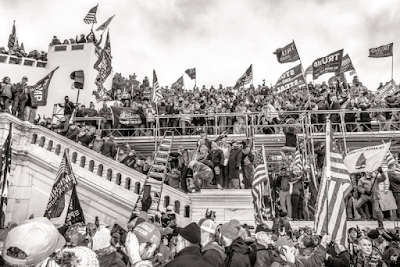Via Peta Pixel
January 31, 2023
Two years on from the Jan. 6 riots, an attack on the U.S. Capitol by Trump supporters, a photojournalist has released his photos from that fateful day.
For his new book Insurrection, Nate Gowdy tells PetaPixel that he was mistaken by some members of the mob as their “fellow patriot,” others assaulted him for being part of the “fake news.”
“Brave photojournalists had to endure hell to navigate that day better than I did,” Gowdy says.
“Many risked endless aggressions to document the battlefront and gore from up close. Not me. Lacking the necessary gear and armor for a combat zone, I captured the wider view. Instead of zooming in with my feet, I often took a step back.”
Gowdy says he was attacked by a group of Proud Boys in the morning and a second time in the afternoon after the perimeter barricades to the Capitol grounds were breached.
“A few insurgents mistook me as a fellow ‘patriot,’ offering water for my burning eyes, confiding in me, and even lending a hand,” he explains.
“The rest of them monitored me with suspicious glares. Because I wasn’t repping my press badge, they couldn’t be 100 percent sure I wasn’t on their team. If I could do it over, I’d cover my N95 with an American flag bandana.
“All afternoon, I worked discreetly, often facing the opposite direction as my lens was pointed, shooting with outstretched arms or from the hip. I religiously avoided eye contact, lest these people take notice of the fear in my eyes. It helped that my lens was wide enough that I didn’t have to point directly at someone in order to include them in my frames.”
Gowdy traveled to D.C. from Seattle to cover what was supposed to be a political rally for Rolling Stone magazine, no different from the many assignments he had been on previously.
But he soon realized that this would be much different and because of the holiday season, Gowdy didn’t have all of his usual gear and was forced to borrow some from a colleague.
“I struggled to adapt to my friend’s custom presets. For the life of me, I couldn’t get used to his ‘back-button AF,’ which separated AF activation from the shutter release,” explains Gowdy
“In no position to troubleshoot, I reset the camera, which made matters worse by somehow removing the AF function altogether! I can laugh at it now, but in my ten years as a photographer, I had never once used manual focus. I’m here to tell you that at a violent insurrection, it’s a difficult thing to learn.”
Virtually all of the photos were taken on Gowdy’s Lecia Q’s fixed 28mm lens and a flash that his friend had lent him.
“Locked between thousands of rioters at the Inauguration Day stand, I was immobile for long periods. The camera’s focal length forced me to focus on and prioritize the subjects and scenes right before me,” he adds.
The Pictures Almost Never Existed
After escaping without serious injury, Gowdy then had the utter devastation of his Leica Q, hard drives, laptop, and all of his pictures being stolen from Washington’s Union Station as he was traveling back to Seattle.
“It was one of the lowest points of my career, and I would’ve given anything to recover these photographs,” he says.
Luckily, one of his friends spotted the camera listed on an online marketplace and Gowdy messaged the seller who claimed to have “found” his backpack that contained all of his stuff. The crook then demanded $2,000.
“Very fortunately, the thief agreed to return to the scene of the crime and to make an exchange the following day at Union Station with a friend of mine,” explains Gowdy.
“Amtrak Police went above and beyond to work with my friend to coordinate a safe and successful sting operation. Everything was returned in time for me to photograph Biden’s inauguration day.”
The 150-page hardcover edition of Insurrection by Nate Gowdy is available via his website.
“If you’re curious to read the only available book of photojournalism about what it was like to be in the middle of the mob on January 6, I encourage you to pick it up,” he adds.





